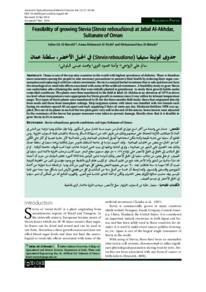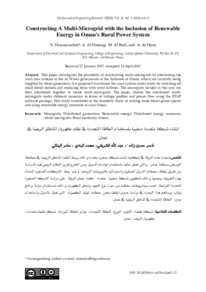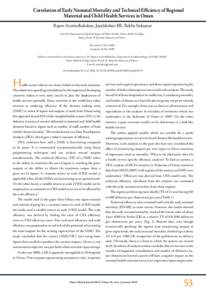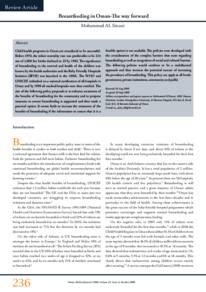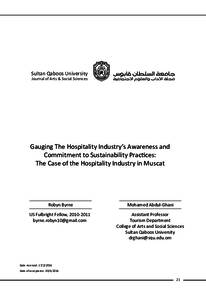Document
Feasibility of growing Stevia (Stevia rebaudiana) at Jabal Al-Akhdar, Sultanate of Oman.
Contributors
Al-Toobiyah, Amna Mahmoud., Author
Al-Balushi, Mohammed Issa., Author
Publisher
جامعة السلطان قابوس. كلية العلوم الزراعية والبحرية
Gregorian
2017
Language
English
English abstract
Oman is one of the top nine countries in the world with highest prevalence of diabetes. There is therefore more awareness among the people to take necessary precautions to preserve their health by reducing their sugar consumption and replacing it with low calorie sweeteners. Stevia is a natural herbal sweetener that is safe and does not have the neurological or renal side effects associated with some of the artificial sweeteners. A feasibility study to grow Stevia was undertaken after obtaining the seeds that were initially planted in greenhouse to study their growth habits under controlled conditions. The plants were then transferred to the field in Jabal Al-Akhdar at an elevation of 1079 m above sea level where temperatures were appropriate for Stevia growth in summer since it was within its tolerant temperature range. Two types of Stevia plants were transferred to JA for the three months field study; those that originated directly from seeds and those from transplant cuttings. Drip irrigation system with timer was installed with two laterals each having six emitters spaced 60 cm apart and each supplying 2 liters of water per day. Moderate fertilizer NPK was applied. Five out of six plants in each of the two plots grew very well to the end of the season. Some insects were attracted by the sweetness of the leaves but proper measures were taken to prevent damage. Results show that it is feasible to grow Stevia in JA in summer.
Member of
ISSN
2410-1079
Resource URL
Citation
Al-Rawahi, S. A., Al-Toobiyah, A. M., & Al-Balushi, M. I. (2017). Feasibility of growing Stevia (Stevia rebaudiana) at Jabal Al-Akhdar, Sultanate of Oman. Agricultural and Marian Sciences Journal, 22 (1), 63-66.
Arabic abstract
عمان هي واحدة من أكثر تسع دول في العالم من حيث نسبة انتشار مرض السكري. ولذا فإن هنالك وعيا متزايدا بن الناس في اتخاذ الاحتياطات اللازمة للحفاظ على صحتهم وذلك عن طريق الحد من استهلاك السكر واستبداله بالمحليات قليلة السعرات الحرارية. ومن المعلوم أن ستيفيا هي عشبة طبيعية وآمنة يمكن استخدامها كبديل للمحليات الصناعية، وليس لهذه النبتة آثار جانبية عصبية أو آثار على الكلى كما هو الحال مع بعض من المحليات الصناعية . ولقد أجريت دراسة في جامعة السلطان قابوس حول إمكانية زراعة ستيفيا في سلطنة عمان وذلك بعد الحصول على البذور من مصادرها، وتم في البداية زراعتها في بيت محمي لدراسة عادات نموها تحت ظروف خاضعة للرقابة. ثم تم نقل النباتات إلى الحقل في الجبل الأخضر على ارتفاع 1079 متر فوق مستوى سطح البحر حيث كانت درجات الحرارة ملائمة لنمو ستيفيا في الصيف. تم نقل نوعين من نباتات ستيفيا إلى الجبل الأخضر وذلك لدراسة هذين النوعين لمدة ثلاثة أشهر؛ يختلف النوعان من حيث أن أحدها قد نشأ مباشرة من البذور وأما الآخر فقد نتج من تقليم السيقان. تم تركيب نظام الري بالتنقيط مع وجود مؤقت في اثنين من الخطوط الفرعية بحيث أن كلا منهما به ست نقاط تبعد 60 سم عن بعضها البعض وتعطى كل منها لترين من الماء يوميا. تم إضافة نسبة متوازنة من أسمدة ت النيتروجين والفسفور والبتسيوم. ولقد لوحظ أن خمسة من أصل ستة من النباتات في كل من قطعتي الأرض نمت بشكل جيد جدا حتى نهاية الموسم. وقد جذبت حلاوة الأوراق بعض الحشرات ولكن تم اتخاذ التدابير المناسبة لمنع الضرر. وأظهرت النتائج أنه من الممكن أن تنمو ستيفيا في الجبل الأخضر في موسم الصيف.
Category
Journal articles

